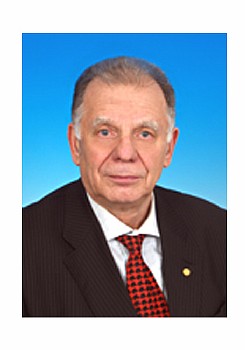|
- - - -
Zhores Alferov
ALFEROV Zhores Ivanovich
(born 15.03.1930)
Founder of physics and electronics of semiconductor heterostructures, Nobel Prize laureate
Zhores Alferov was born in Vitebsk. In 1952 he graduated from Leningrad Electrotechnical Institute. Since 1953 he worked at the Physical-Technical Institute of the Russian Academy of Sciences (Director from 1987 till 2003), at St. Petersburg Electrotechnical University (Head of chair since 1973) and St. Petersburg State Technical University (the Dean of the Physical-Technical Faculty since 1988). Alferov has been Chairman of the Presidium of St. Petersburg Scientific Center since 1989, and the Vice-President of the Russian Academy of Sciences since 1990. In 1970 he received his doctorate in physics and mathematics, in 1973 got the rank of professor. Alferov is an academician of the Russian Academy of Sciences (1979), a foreign member of the Polish Academy of Sciences (1988), the National Academy of Sciences of Belarus (1995), the National Academy of Sciences and National Academy of Engineering Sciences of the USA (1990), of academies of sciences and scientific societies of other countries. In 2001 Alferov established the Foundation for Support of Education and Science (Alferov's Foundation) to bring together the intellectual, financial and organizational efforts of Russian and foreign natural and legal persons to facilitate the development of Russian science and education. Since 2010 Alferov has been a co-chairman of the Advisory Board of the Development Fund for Skolkovo Innovation Center.
Alferov’s scientific papers include those on semiconductor physics, quantum and semiconductor electronics. Alferov contributed to designing the first in the USSR transistors, photodiodes and germanium power rectifiers. He discovered the superinjection effect, offered ideal semiconductor heterostructures such as "aluminum arsenide – gallium arsenide" (1967). On their basis, he created light-emitting diodes (1968) and solar cells (1970), semiconductor lasers operating in continuous mode at room temperature (1970), which led to the development of fiber-optic communication lines, data processing laser systems. He was the first to attain the injection heterolasers based on quantum dots (1993–1995), thus laying the foundation of band engineering. Alferov won the Nobel Prize in Physics in 2000 for basic work on information and communication technology by developing semiconductor heterostructures used in high-speed- and opto-electronics. Alferov also became the Laureate of the Lenin Prize (1972), the Hewlett-Packard Europhysics Prize (1978), the State Prizes of the USSR (1984) and the Russian Federation (2001), the Global Energy International Prize (2005). He was awarded the Order of Lenin (1986), the Order of October Revolution (1980), the Order of the Red Banner of Labour (1975), the Badge of Honour (1959), the Orders of Merit for the Motherland of I–IV degree (Russia, 1999, 2000 , 2005, 2010), the Order of Francisk Skarina (Belarus, 2001), the Order of Prince Yaroslav the Wise (Ukraine, 2003), the UNESCO Medal for "Contributions to the development of nanoscience and nanotechnology" (2010), and medals of the USSR and the Russian Federation. Alferov is the Honorary Citizen of Minsk (2002) and Vitebsk (2003). There is a minor planet named after him.
Works:
1. Физика и жизнь. 2 изд. М.; СПб.: Наука, 2001.
2. Наука и общество. СПб.: Наука, 2005.
3. Scienza e Societa. Roma: Sandro Teti Editore, 2006.
Literature:
1. Josephson P. R. Lenin's Laureate: Zhores Alferov's Life in Communist Science. The MIT Press, 2010.

© National Academy of Sciences of Belarus, 2011
|
|


